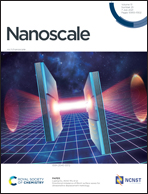Electrocatalytic generation and tuning of ultra-stable and ultra-dense nanometre bubbles: an in situ molecular dynamics study†
Abstract
Electrocatalytic generation of nanometre gas bubbles (nanobubbles) and their tuning are important for many energy and chemical processes. Studies have sought to use indirect or ex situ methods to investigate the dynamics and properties of nanobubbles, which are of fundamental interest. Alternatively, we present a molecular dynamics simulation method, which features in situ and high spatial resolution, to directly address these fundamentals. Particularly, our simulations can quantitatively reproduce the generation of ultra-stable and ultra-dense nanobubbles observed in electrochemical experiments. More importantly, our results demonstrate that the classical nucleation theory is still valid even for the scale down to several nanometres, to predict the dynamics and properties of nanobubbles. This provides general guidelines to design efficient nanocatalysts and nanoelectrodes. In our specific case, nanoelectrodes with wetting angles below 71° can suppress the generation of surface nanobubbles.



 Please wait while we load your content...
Please wait while we load your content...